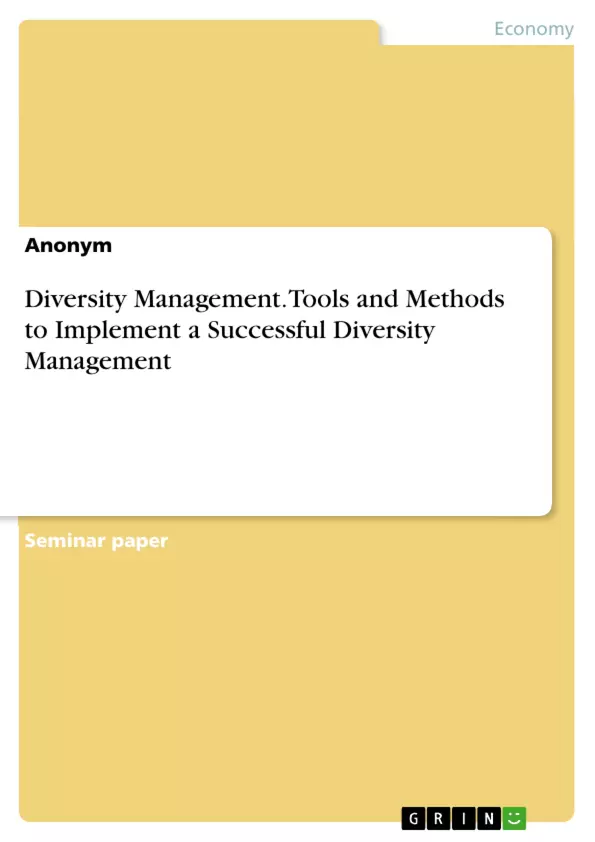This essay presents various tools and methods that companies can use to implement a successful diversity management. In order to create a fundamental understanding of diversity and its management, the objectives and various dimensions are explained in more detail in advance.
The transformation of our modern world into an increasingly diverse society is creating new circumstances and also new challenges for companies. The number of women working full-time or part-time is increasing and international collaboration is being enhanced by globalization.
Through immigration, our society is experiencing new cultural influences and the public is becoming more tolerant of different sexual orientations than in the past. Therefore, companies should not only recognize the diversity in their workforce, they need to be aware of their increasing duties as employers and establish a diversity management in the organization.
Table of Contents
- Introduction
- Diversity Management
- Objectives
- Dimensions
- Tools and Methods
- Gender
- Nationality and Cultural Background
- Age
- Sexual Orientation
- Disabilities
- Overall
- Conclusion
Objectives and Key Themes
This essay aims to provide companies with tools and methods for successfully implementing diversity management. It begins by establishing a fundamental understanding of diversity and its management by detailing its objectives and dimensions. The essay then explores various tools and methods for implementing effective diversity management practices.
- The definition and significance of Diversity Management (DM)
- The various dimensions of diversity within a workforce (gender, age, nationality, etc.)
- The objectives of DM in achieving business success and increased profitability
- Tools and methods for implementing successful DM strategies
- The challenges and opportunities presented by a diverse workforce
Chapter Summaries
Introduction: This introductory chapter sets the stage for the essay by highlighting the increasing diversity in modern workplaces due to factors like globalization, immigration, and evolving societal attitudes. It emphasizes the growing need for companies to not only recognize but also actively manage this diversity. The chapter lays the groundwork for exploring the tools and methods needed for successful diversity management, promising a deeper dive into the objectives and dimensions of diversity in subsequent sections.
Diversity Management: This chapter defines "diversity" as encompassing various differences among individuals, including gender, age, nationality, sexual orientation, disabilities, and religion. It distinguishes between "Diversity Management (DM)" as a strategic, integrative management concept aimed at optimizing the work environment, and "Managing Diversity" as a focus on mitigating disadvantages arising from these differences. The chapter underscores that DM is not solely about diversity itself but about achieving business success and improved profitability through effective management of diverse workforces.
Tools and Methods: This chapter delves into the practical application of diversity management by presenting various tools and methods companies can use to create inclusive work environments. It likely covers specific approaches tailored to address the unique challenges and opportunities related to each dimension of diversity explored in the previous chapter (gender, nationality, age, sexual orientation, disabilities). The focus is on providing actionable strategies for companies to effectively manage their diverse workforces and turn diversity into a competitive advantage.
Keywords
Diversity Management, Diversity, Inclusion, Workforce Diversity, Organizational Culture, Equal Opportunity, Business Success, Strategic Management, Human Resources, Employee Engagement, Cultural Awareness, Gender Equality, Age Diversity, Disability Inclusion, LGBTQ+ Inclusion.
Frequently Asked Questions: A Comprehensive Language Preview on Diversity Management
What is the purpose of this document?
This document provides a comprehensive preview of a text on Diversity Management. It includes the table of contents, objectives and key themes, chapter summaries, and keywords, offering a structured overview of the subject matter.
What topics are covered in the document?
The document covers the following key areas: The definition and significance of Diversity Management (DM), the various dimensions of diversity in the workplace (gender, age, nationality, sexual orientation, disabilities, etc.), the objectives of DM in achieving business success, tools and methods for implementing successful DM strategies, and the challenges and opportunities presented by a diverse workforce.
What are the main objectives of Diversity Management as discussed in the document?
The primary objective of Diversity Management, as presented, is to optimize the work environment and achieve business success and increased profitability by effectively managing a diverse workforce. It's not merely about acknowledging differences but strategically leveraging them for competitive advantage.
What are the key dimensions of diversity considered in the document?
The document explores several key dimensions of diversity, including gender, age, nationality, cultural background, sexual orientation, and disabilities. Each dimension is likely examined in terms of its unique challenges and opportunities within the context of Diversity Management.
What tools and methods for implementing Diversity Management are mentioned?
While specific tools and methods aren't detailed in the preview, the document promises a discussion of practical approaches tailored to address the challenges and opportunities associated with each dimension of diversity, providing actionable strategies for companies.
What are the chapter summaries included in the preview?
The preview includes summaries for an Introduction chapter (setting the context for the importance of Diversity Management), a Diversity Management chapter (defining the concept and its strategic goals), and a Tools and Methods chapter (detailing practical applications for creating inclusive work environments).
What are the keywords associated with this document?
The keywords include: Diversity Management, Diversity, Inclusion, Workforce Diversity, Organizational Culture, Equal Opportunity, Business Success, Strategic Management, Human Resources, Employee Engagement, Cultural Awareness, Gender Equality, Age Diversity, Disability Inclusion, and LGBTQ+ Inclusion.
Who is the intended audience for this document?
The intended audience appears to be companies and individuals seeking to understand and implement effective Diversity Management strategies. The information is presented in a professional and academically-focused manner.
Where can I find more information?
The preview suggests that the full text would contain a detailed exploration of the topics mentioned. Access to the full text is necessary to gain a complete understanding of the methodologies and strategies discussed.
- Quote paper
- Anonym (Author), 2020, Diversity Management. Tools and Methods to Implement a Successful Diversity Management, Munich, GRIN Verlag, https://www.grin.com/document/921598



